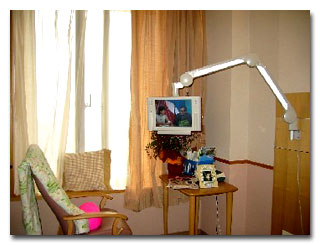Accessible medical care center including the elderly and disabled people(Nov.2002)

On Sep. 6, 2002, Shizuoka Cancer Center, a new prefectural center, started operation at the foot of Mt. Fuji in Shizuoka Prefecture. It was constructed at a cost of 58 billion yen and is equipped with various cutting-edge facilities. As a specialized hospital, it is aiming at becoming not only a world-class hospital in terms of cancer treatment, but also "an excellent patients-centered establishment". At this time we would like to introduce the hospital, also focusing on the need to accommodate the elderly and persons with disabilities.
Three Pillars
Mr. Ken Yamaguchi, the president of the center, clearly explained its three pillars approach to patient treatment, or "promises to patients".
The first pillar is "successful cancer cure"- curing cancer without delay, with less pain, and without impairing physical functions. In order to aid the fulfillment of this goal the hospital has an annex with a proton-beam radiotherapy facility, the newest in the world. The second pillar is "supporting patients and their families". Various considerations (described later) have been given based on this promise. The hospital will also focus on mental health care, rehabilitation and promotion of social integration of persons who have become disabled because of operations such as removal of cancerous tumor. President Yamaguchi says, "We are in the position to give patients cancer treatment which, unfortunately and inevitably, may sometimes result in the impairment of physical functions. However, reducing the level of such disability, fully utilizing the remaining functions and enhancing the patients' quality of life after they leave hospital are important tasks for us".
Director Tetsuya Tsuji, of the Rehabilitation Division emphasizes the importance of supporting patients in cooperation with community organizations and agencies. He says "we will talk with the parties concerned to give them an opportunity to understand disabilities, and discuss how we can cooperate to support patients, so that they can be smoothly integrated into society after they leave hospital. We will also provide rehabilitation service."
The third pillar is "growth and evolution". As a hospital that provides the excellent cancer treatment and top-rate facilities, the staff always desires to improve themselves and the hospital focuses on studying the state-of-the-art diagnosis and treatment method, cancer immunotherapy and nursing technique.
Vigorously Pursuing Universal Design
The facility aims to be 'barrier free', pursuing both individuality in design concepts and giving thorough consideration to visitors. There are 70 volunteers in all, who have all undergone an eight-day training session. They wait at the entrance with smiling faces and escort patients.
The center has an English garden, a garden with 1,600 roses, and another with a pond and green plants, encouraging the mental healing of the patients and enhances the motivation to their treatment. The center is called 'The Garden Hospital' due to the inclusion of these facilities.
With regards to the design of the rooms the nurses opinions were taken into account, with overall aim of making the patients feel as comfortable as possible.
Fine arts on the walls of corridors are all painted with natural pigments and promote reflection and peace of mind.
Utilization of IT

The hospital has introduced an information system using IT to be used by doctors and nurses. Eliminating all paper-based charts, they will adopt electronic charts and all information about a patient would be written in by a medical team. Each chart will include requests from the patient and his or her family. It also has a message board, where doctors and staff will write in and exchange information. With consent of the patient, doctors in private practice and the center can also exchange this information. With a touch panel terminal installed at each bedside, patients can obtain various information: their blood test results, an explanation of treatment, information by disease. They can also make a request for changes in their meal order or search books in the library at the hospital. It can also be used as the terminal for television and radio. The PCs in day rooms on each floor are equipped with Internet terminals.
Consultation Service of Any Kind
One of the unique services provided to citizens by the hospital is "consultation service. It starts a free telephone service, so that people can feel free to ask a professional about their health worries. Coping with various individual cases, doctors, nurses, pharmacists, dietitians, welfare workers, rehabilitation staff, etc. will answer their questions. An e-mail consultation service and the second opinion consultation service by appointment are available.
Patient Library
Also worthy of special note is that it is the first hospital in Japan that has a patient library with a full-time professional librarian within its premises. The library houses about 2,000 books, about 500 of which are concerned with medical issues, so that patients and their families can study disease by themselves. The library will purchase books upon request, and for individuals with visual impairments, it houses large print books.

There are two computer terminals for searching library's collection, two terminals for Internet use, and two video rooms, where video films can be watched. The library has a seminar room, where patients and their families can hold a study session with doctors and experts. The library is also open to outpatients, medical staff and the public. Mr. Yu Kikuchi, who has been serving as an advisor to the library three years prior to its opening, expresses his wishes as the librarian and says, "We would like to increase the number of books and provide culture as well as medical information to people who visit here".
As all of these functions at the hospital work well, and in turn achieve patient-centered medical care. The efforts being made by this medical facility should provide a model for the treatment of mental health for patients including the elderly and persons with disabilities, who tend to be ignored.
